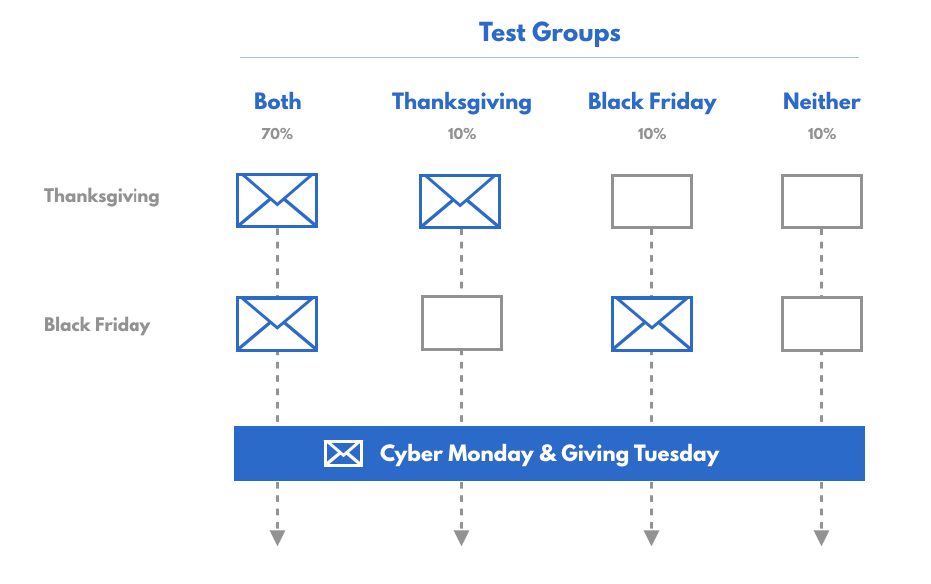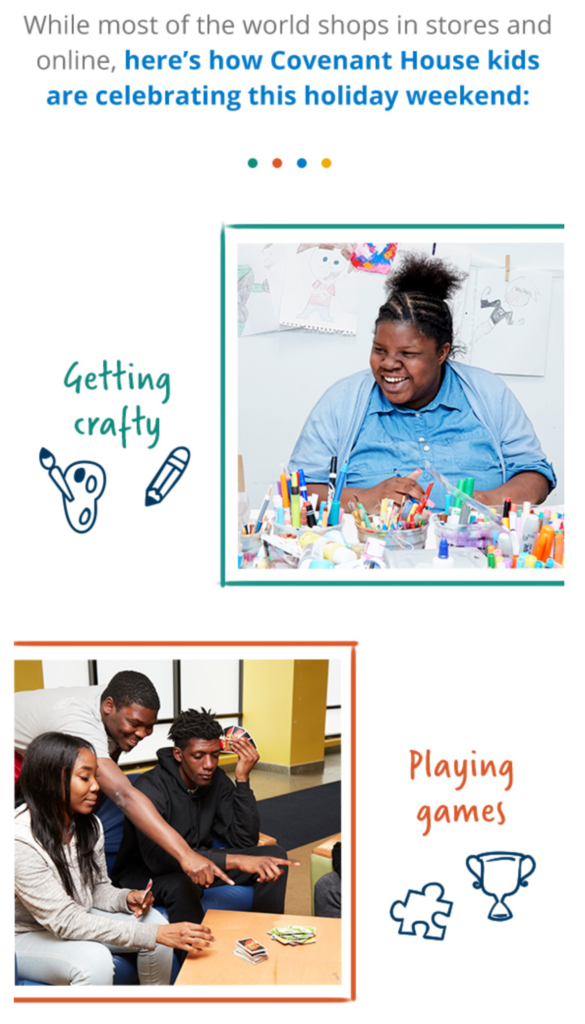We’re all gearing up for an onslaught of messages asking us to spend money: on sales, on stuff, and on the causes we care about.
Every organization wants to stand out in the sea of emails so that its supporters take notice and donate. And there’s a lot you can do on Giving Tuesday—arguably the second most important moment of the year for nonprofit fundraising—to get attention and drive conversions.
But what you may not be thinking about is what you send before Giving Tuesday, and the power of those sends to prime your list and increase overall giving on the big day.
We’ve been thinking about it, though. For years. And with some longitudinal, multi-year testing, we can recommend what to send before Giving Tuesday to help push your revenue sky high.
The Tests: In 2017 and 2018 we performed two tests with our partners at Covenant House International to see if sending emails on Thanksgiving and Black Friday can lift results on Giving Tuesday. We tested volume (sending lots of emails vs. a few emails vs. none at all) and message (cultivation vs. fundraising). Here’s what we learned:
Let’s start with our test in 2017. We split our audience into four random groups, and each received a different cadence of emails prior to Giving Tuesday:

The question: Of these groups that received very different email cadences over Thanksgiving and Black Friday, which one performed best during Giving Week in terms of donations?
The answer: The first group—the group that received both Thanksgiving and Black Friday appeals (i.e. the most emails)—performed better than the experimental groups at a statistical level.
When looking at the proportion of each group that donated by the end of Giving Tuesday, the first group was 30% more likely to donate than the Thanksgiving-only group, 42% more likely to donate than the Black Friday-only group, and 18% more likely to donate than the group that received no emails ahead of Giving Week. Each of these comparisons was significant at the 99% confidence level and all other metrics, like unsubscribe rate, remained steady.
The big takeaway from 2017: To drive more donations on Giving Tuesday, it’s best to prime supporters with two emails sent on Thanksgiving and Black Friday.
Heading into 2018, we knew we wanted to email Covenant House supporters on Thanksgiving AND Black Friday, thanks to our 2017 test. What we wanted to learn this time around was which types of priming messages would be most effective in driving donations on Giving Tuesday: cultivation or fundraising emails.
We designed our test around two randomized groups: Group A received a fundraising email on Black Friday, while Group B received a non-fundraising cultivation email on Black Friday. Both groups received a cultivation email on Thanksgiving, and both received the same fundraising emails during Giving Tuesday.
The question: Will priming emails sent ahead of Giving Tuesday ultimately yield better donor conversion results on the big day?
The answer: Group B, which received the non-fundraising cultivation email on Black Friday, was 7% more likely to make a donation over the course of the Giving Week campaign (results were 95% statistically significant).


The big takeaway from 2018: Sending a cultivation email, rather than a fundraising ask, prior to Giving Tuesday results in greater conversions overall. This also reinforces a reality of email fundraising we’ve long known: priming supporters with cultivation messages before fundraising campaigns improves subsequent revenue!
The Results: From our tests in 2017 and 2018, we learned that to optimize conversions on Giving Tuesday, Covenant House should.
- Send email to supporters on Thanksgiving AND Black Friday; and
- Make those cultivation messages, rather than fundraising messages.
Heading into Giving Tuesday 2019, we’re doing just that. Covenant House supporters will receive a heartwarming thank you send on Thanksgiving, followed by another cultivation send on Black Friday.
While learnings are never one-size-fits-all in an industry as diverse as nonprofit fundraising, this Thanksgiving week email cadence is a good place to start, or it might inspire your own longitudinal tests. Like we tell all of our clients, the best way to determine whether a tactic is effective for your organization is to test it for yourselves.